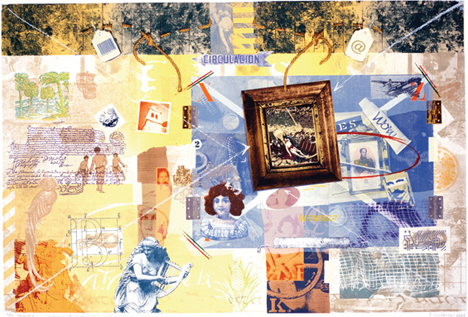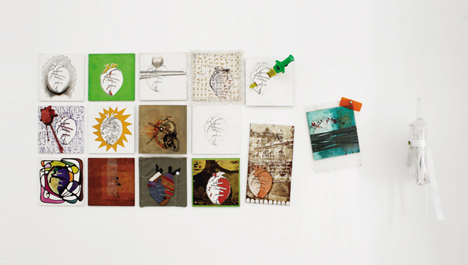ROMEO GALDáMEZ
PEOPLEText: Erika Saca
Hollywood superstars, soldiers, and indigenous people live in perfect harmony among bar codes, lotería cards, and sweatshop sewing machines. This is the world as seen through the eyes of Romeo Galdámez, the Salvadoran graphic artist, whose collages merge the fragments of our Latin American identities into spectacular pieces of art. In his work, contradicting textures and paradox realities come together to make both a graphic and an ideological statement. Think Rauschenberg meets García Canclini’s Hybrid Cultures. A master of serigraphy (also known as silkscreen), he’s re-dimensioned this flat technique, popular in poster art, and given it new volumes.
Like many Salvadoran artists of his generation, the 12-year civil war meant fleeting the country for many years. Last month, he had his first solo exhibition in El Salvador, after his return to the country, four and a half years ago. I sat down with Romeo on the last day of his show, POSDATA, (Postscript or P.S. in English) to talk about art, Latin America, and where we stand in the global picture.

Romeo Galdámez
Why POSDATA?
POSDATA is an exhibit that I had prepared since I came back to El Salvador, four and a half years ago. Posdata is what you write at the end, that you could not write in the body of the letter, it’s a compliment of the information.

Romeo Galdámez “Códice Nuestro Fin de Siglo y Otras Páginas de Memorias” (2001)
It’s also a sample of the work I did on my journey in other countries, outside El Salvador. POSDATA is a subsequent delivery, where there are two new works that were done on my return. “Mosaico de Corazones” was made in collaboration with 16 young artists, some which were not even born when I left the country. I’m delivering graphic sums to my country.

Romeo Galdámez “Mosaico de Corazones” (2008)
Since when did you become involved with art? Did you always want to be an artist or did it cross your mind to be, say… a doctor?
I was born in a small town in the department of Cabañas. I always wanted to explore and know more and looked at my context from different angles. Art allowed me to see my world in a different light.
I was given the opportunity to study at the National Center of the Arts in ’72, which back in the day had a great program with foreign teachers that gave us new points of view.
Even though I knew that studying this career was almost an act of heroism and bravery, I knew it was going to bring other kinds of satisfactions. This was the kind of career that you knew was not going to bring bread to the table because of the social and economic conditions of our country. In short, at this point in my career, I can say that thanks to art I’ve had a notion of the world, I’ve traveled the world, met very interesting people.
Read more ...




